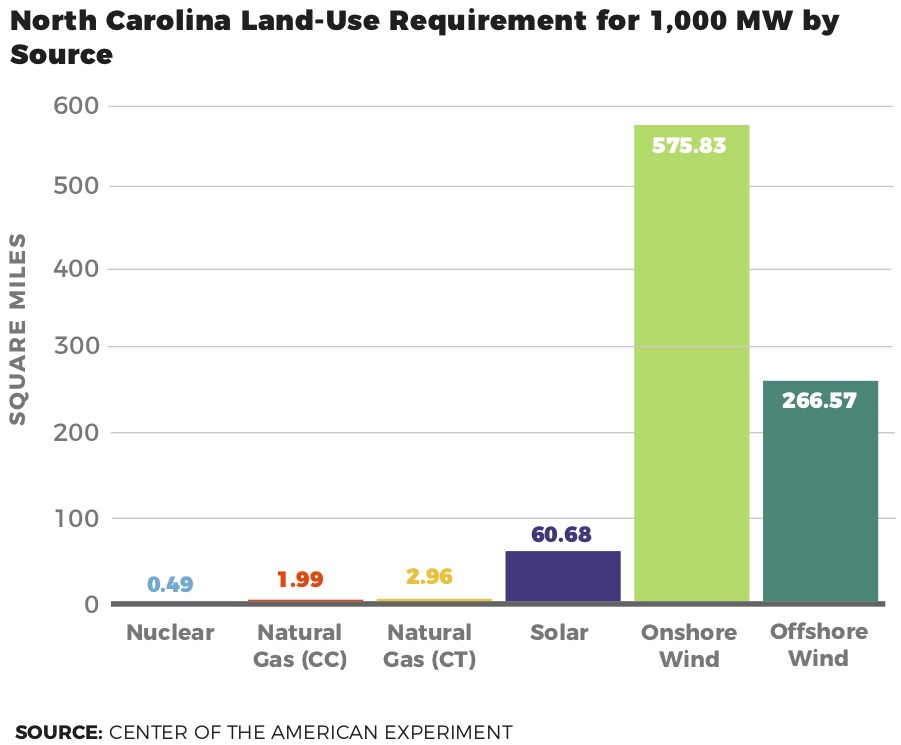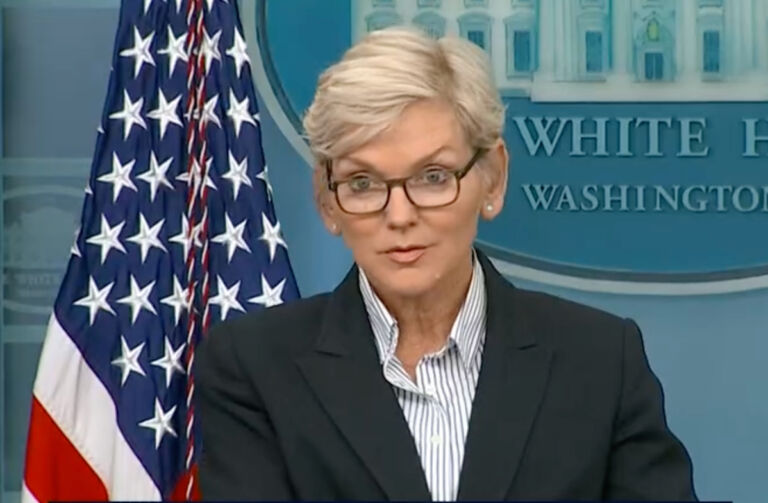- The Utilities Commission wants Duke to model taking on onshore wind generation and study offshore wind generation
- Onshore wind generation is very expensive, needs costly transmission upgrades, and also requires by far the largest amount of land
- Meanwhile, offshore wind’s costs are staggering for a fickle electricity generation source that, like onshore wind, only works when the wind is blowing within certain speeds — something grid operators can only hope coincides with people’s need for electricity at the moment
Background: At year’s end 2022, the North Carolina Utilities Commission (NCUC) released an initial “Carbon Plan” for future electricity generation in North Carolina. The NCUC issued this plan in response to a law passed in late 2021, House Bill 951. That law took Gov. Roy Cooper’ arbitrary, aspirational goal in certain executive orders to reduce the state’s carbon dioxide (CO2) emissions from electricity generation by 70 percent from 2005 levels around 2030 (and then to net zero by 2050).
What the law does that the governor would not, however, is institute extremely important protections for the grid and for electricity consumers.
Those protections in law include the following requirements that a plan approved by the NCUC must meet (emphasis added):
• be “reasonable“
• set forth the “least cost path … to achieve compliance”
• comply with “current law and practice” regarding “least cost planning of generation“
• “maintain or improve upon the adequacy and reliability of the existing grid”
They are in keeping with North Carolina’s longtime protections in law. Recognizing that “the rates, services and operations” of electric power utilities are “affected with the public interest,” the law makes it state policy to require “adequate, reliable and economical utility service to all of the citizens and residents of the State” as well as “the least cost mix of generation and demand-reduction measures which is achievable.”
The State of North Carolina has long recognized that least-cost, reliable electricity at the flip of a switch is in the public interest. By seeking the “reasonable,” “least cost path” to emissions reductions with “least cost planning of generation” that would “maintain and improve upon the reliability of the grid,” the text of the law seeking to reduce North Carolina’s electricity-based CO2 emissions recognizes the very same ideal.
The first brief in this series discussed the plan’s mandates to retain existing nuclear power plants, look into adding more nuclear, and also to retire all coal plants by 2035. The second brief discussed the mandates to add more natural gas generation and ensure more natural gas is available here. The third brief examines the plan’s mandates to procure new solar generation and batteries right away and upgrade transmission facilities for interconnecting all this new solar, and it also discussed the ramifications of Duke Energy already requesting large new rate hikes mostly to pay for electric grid infrastructure improvements made necessary by the plan.
This brief will examine the NCUC plan’s mandates involving onshore and offshore wind generation, focusing on whether they would help keep the plan within the law’s all-important parameters.
Wind: Start planning for onshore facilities, and see if you can make offshore wind feasible
Mandates:
- Directs Duke to engage with onshore wind stakeholders and economically model utility-owned onshore wind in its next round of modeling
- Directs Duke to study and consider the acquisition and development of wind lease areas off the coast of North Carolina
The NCUC found the pursuit of onshore wind generation compelling given that “[e]very portfolio in Duke’s Carbon Plan proposal,” including two supplemental plans, “selected 600 MW of onshore wind.” The commission found that “the characteristics of onshore wind make it a compelling complement to solar generation that could help foster system reliability.” What that means is that wind can blow when the sun isn’t shining, and the sun can shine when the wind isn’t blowing. It would hardly be unusual, however, for sun and wind both to be absent.
In other words, onshore (and offshore) wind adds a different layer of unreliability and intermittency to solar’s unreliability and intermittency. This redundancy of unreliability is not the same as efficient, reliable generation, though. By way of comparison, the model “Least-Cost Decarbonization” portfolio submitted to the NCUC by Locke’s Center for Food, Power, and Life (CFPL) was able to accomplish the law’s emissions-reduction targets without any wind generation.
Nevertheless, the NCUC ordered Duke to “engage with onshore wind stakeholders and economically model” wind because the commission was unsure “whether Duke can reasonably put into service 600 MW of utility owned onshore wind in order to achieve the Interim Target” (of 70 percent CO2 emissions reductions by 2030). “Stakeholders” is a mercenary term for groups who stand to profit from government forcing an option on captive ratepayers. As the CFPL vision statement puts it,
Too often in the public-choice wrangling among “stakeholder” cronies and special interests, policymakers can lose sight of who the main stakeholders are, the ones with the most at stake: we the people.
Onshore wind generation is very expensive, needs costly transmission upgrades, and also requires by far the largest amount of land. Just to produce 1,000 MWs of generation, onshore wind would require a larger land footprint than Mecklenburg County. For the same amount of generation that takes onshore wind 576 square miles to produce (when the wind is blowing), natural gas needs only two square miles. And nuclear? Only a half square mile.

One thing that is more expensive than onshore wind generation, however, is offshore wind generation. Several aspects of offshore wind caused the NCUC to ask for a study rather than order Duke to dive right in. They include a “near-term cost” to Duke of offshore wind development of $317.4 million, the uncertainty of the capacity factors (how much output could be expected) of any developed wind energy area offshore, the fact that the Kitty Hawk wind energy area would require “roughly 100 miles of additional cabling,” the uncertainty of whether Kitty Hawk could even be developed to benefit Duke’s customers, and the unique threat of hurricanes off the coast of North Carolina (other offshore wind sites don’t have the hurricane activity that North Carolina does), among other things.
Those costs of offshore wind extend well beyond the capital and construction costs, however, even as those alone would significantly add to consumers’ power bills as those costs get passed through to Duke’s customers. As CFPL demonstrated, the costs of offshore wind include:
- Tens of thousands of jobs owing to electricity price hikes alone
- Major damage to coastal communities’ largest industries: fishing and tourism
- Significant increase in North Carolina’s already dangerous level of energy poverty
- Ominous threats to marine wildlife, including dozens of endangered species, and also seabirds, gulls, and endangered migratory birds
Ugly arrays of turbines gashing the viewshed that beachgoers enjoy would distinctly harm coastal tourism, as North Carolina State researchers found. Their study of beach tourists’ sensitivity to visible wind turbines involved turbines over 500 feet tall. The Carbon Plan noted, however, “opportunity to create larger and taller wind towers.” The turbines under discussion now are over 1,000 feet tall. By way of comparison, the Bank of America Corporate Center in Charlotte (the state’s tallest building), which is visible from Grandfather Mountain, is 871 feet tall.
Offshore wind’s costs are staggering for a fickle electricity generation source that only works when the wind is blowing within certain speeds — something grid operators can only hope coincides with people’s need for electricity at the moment. Duke won’t be upset if the NCUC orders them to build large amounts of depreciable capital assets paid for by ratepayers, but even if the commission tosses aside their “least cost” strictures, North Carolina’s electricity consumers ought to be able to expect them to maintain the reliability of their power. Not this:
Europe is already showing what happens to people when governments heedlessly discard dispatchable power generation for electricity at nature’s whim. Last year’s European “wind drought” was a warning. Forecasts for the upcoming winter predict exceptional cold. Worse, the dreaded “Dunkelflaute” is setting in again, the “dark doldrums” of still air (no wind) and little sunlight in the winter months.
Burdening the grid with so much weather-dependent renewable resources, solar and wind, harms reliability so much that it makes demand spikes from weather extremes not the only — or even the worst — threat to grid reliability, but dull days “when weather-dependent generation is impacted by abnormal atmospheric conditions or when extreme conditions disrupt fuel supplies”:
The looming threat of a dull day is something warned about in a new report from the Colorado Public Utilities Commission. … As reported by Colorado Public Radio, more solar and wind facilities on the grid would mean that “long periods of still, overcast weather,” rather than extreme temperature events, pose the greatest challenge. As report author Nicholas Garza put it, “What we would think of as very benign or very boring weather, where you have just persistent cloud coverage and really no wind, that’s actually going to pose the most significant threat.”
North Carolina’s Utilities Commission should rethink forcing expensive onshore and offshore wind generation on the grid. North Carolinians deserve better — and the law demands better for them — than to pay significantly higher rates to support generation sources that put their power at risk even in “boring weather.”
The next brief in this series will discuss the Carbon Plan’s surprising admissions that interconnecting solar and wind facilities imposes significant costs on people and that those costs are greater the more solar and wind generation is added.


